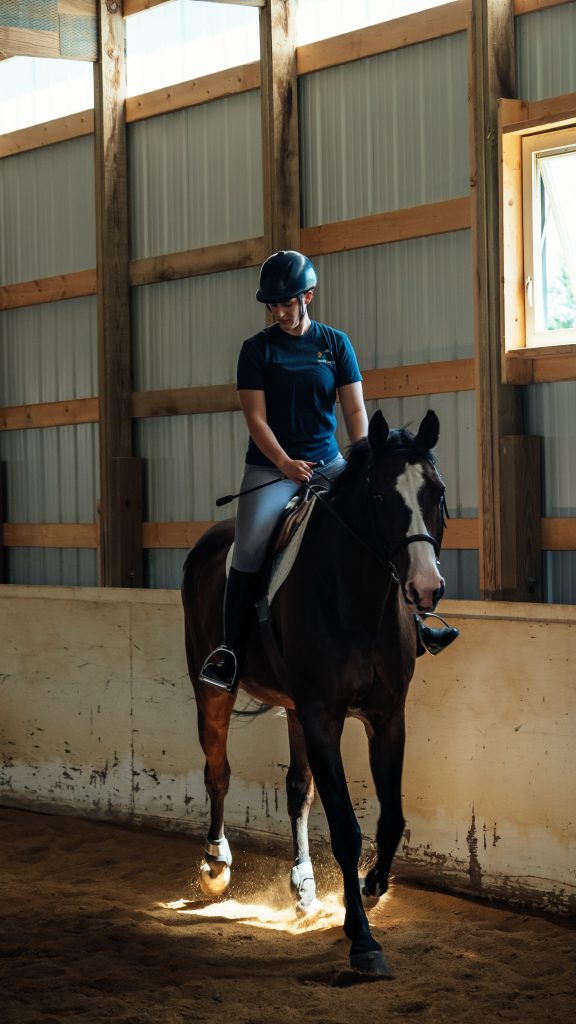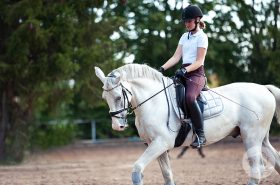Whether you ride English, or Western, at some point along the way you are going to hear about how important it is that you develop an independent seat in your riding. The day will come when your riding instructor will say something similar to, “Stop driving the horse with your seat!” Or, “Stop pulling on your reigns! Use your seat to cue for a halt!” For a beginner you may be wondering, “What in the world are they talking about?” And my goodness the analogies you may get from asking that very question! I’m not an expert, but for the sake of riding instructors, and beginner students everywhere, I have decided to share how the concept of using your seat finally made sense for me.
The Struggle Was Real
Thinking back to the riding lessons that I took several years ago, one of the concepts that I struggled with the most was figuring out how to correctly “use my seat.” In my first two years of riding out on the trails, no one had ever mentioned anything about how my seat affected the horses movement. It wasn’t until I began taking lessons with a dressage trainer that I started to hear all about how incorrectly I was using my seat. Time, and time again I would try to cue the horse for a downward transition, or a halt using my seat, only to end up getting corrected for unknowingly using my reins, and then tipping forward in the saddle when the horse finally stopped.
My instructor tried to explain the concept of using my seat in many different ways. She even demonstrated it for me several times, but I just didn’t get it. I had a hard time trying to focus on what she was doing with her seat, legs, and hands while she was on a moving horse, let alone when I was. For me, it was too much information, too fast, and all at once. The concept of how I was supposed to move my body with the horse, and then suddenly stop moving my body to cue for a halt, either didn’t make any sense, or felt nearly impossible to do.

The Light Bulb Moment
A couple years later I finally had a light bulb moment of understanding what “using my seat” meant. It came when I was searching the internet for exercises to help with some pain I had been having in my knees, and hip joints. In the process I found a video by Dr. Trevor Bachmeyer on YouTube talking about how to correct anterior pelvic tilt. In case you’re wondering, anterior pelvic tilt is when the pelvis (your hip bones) are tilted forward due to one muscle group being weaker than another muscle group in your lower body. Dr. Bachmeyer explains that if you compare the pelvis, to being like a bucket of water you need to have the ability to move your pelvis forward, backward, and side to side with all of those muscles in order to keep the bucket level.
When Dr. Bachmeyer demonstrated two exercises in the video (the supine posterior tilt, and the standing posterior tilt) I was instantly reminded of what my riding instructor had been trying to explain to me about using my seat. I also realized that what I had previously thought was good riding posture, was actually putting my body into anterior pelvic tilt, and throwing off my balance. Normally when I hopped in the saddle I would try to sit up as straight as possible, and get my legs positioned under me. When I did that however, I ended up hollowing out my back, and stiffening my entire body. The poor lesson horses must have felt like they were trying to balance a corpse on their
back! Ultimately my stiff posture would cause me to roll forward on my hip bones, leaving me feeling pretty unbalanced. I then made the same mistake that many other riders have made when they feel unbalanced; I tried to compensate by using my hands, or gripping more with my knees as a way to try to find stability. Though it seems logical to hold on tighter to something when you feel off balance, that logic doesn’t work so well with horses.
We All Learn Differently
If you have also struggled with learning to use your seat, remember to give yourself some grace, we all learn differently. I’m a visual learner, but I also thrive on learning one piece of information at a time. This new understanding of how the human body works helped me so much! It was relieving to finally understand why I had struggled to cue the horse for a downward transition, or a halt, and why I always tipped forward when the horse finally stopped. The explanation from the YouTube videos helped me to zoom in, and focus on that one area, so that I could learn what to do before even getting on the horse. By practicing the movements out of the saddle I was able to strengthen, and mobilize the muscles that I would be using in the saddle. With this new knowledge, and functionality off the horse, I was then able to practice on the horse. First at a stand still, then progressively through each gait.
Knowledge Is Muscle Power
There are so many benefits to learning how the human body moves in motion, as well as learning how the horses body moves in each gait. Knowing what we need to do with our bodies before we get on the horse, helps us build confidence in our abilities, while practicing different exercises helps us to gain muscle memory before we add in a 1200+ pound free spirit into the mix.
Leave us a comment, and tell us about when “using your seat” really clicked for you!
Love this blog post? We think you will like How to Get a Stronger Leg



